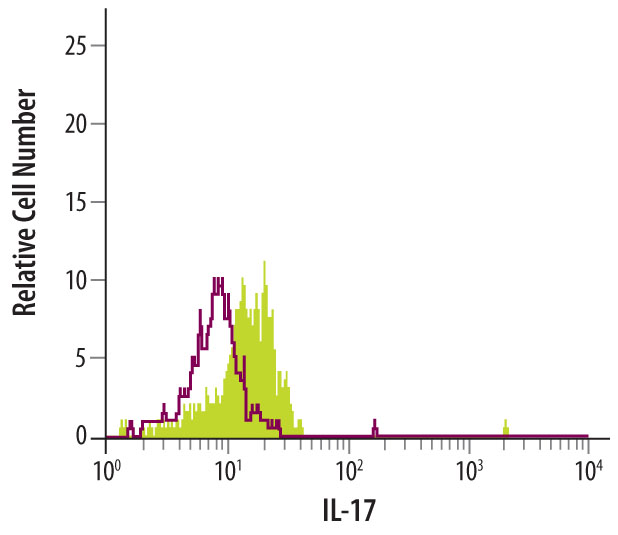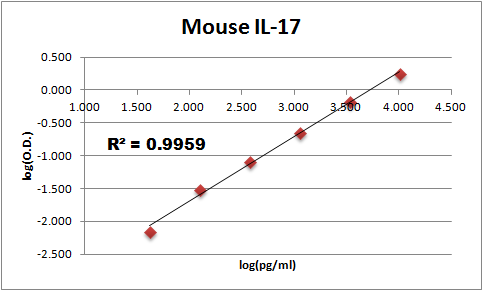Mouse IL-17/IL-17A Antibody Summary
Thr22-Ala158
Accession # Q62386
Applications
Please Note: Optimal dilutions should be determined by each laboratory for each application. General Protocols are available in the Technical Information section on our website.
Scientific Data
 View Larger
View Larger
Detection of IL-17 in EL-4 Mouse Cell Line by Flow Cytometry. EL-4 mouse lymphoblast cell line was treated for 16 hours with 50 ng/mL PMA then stained with Goat Anti-Mouse IL-17 Antigen Affinity-purified Polyclonal Antibody (Catalog # AF-421-NA, filled histogram) or isotype control antibody (Catalog # AB-108-C, open histogram), followed by Phycoerythrin-conjugated Anti-Goat IgG Secondary Antibody (Catalog # F0107). To facilitate intracellular staining, cells were fixed with paraformaldehyde and permeabilized with saponin.
 View Larger
View Larger
IL-6 Secretion Induced by IL-17 and Neutralization by Mouse IL-17 Antibody. Recombinant Mouse IL-17 (Catalog # 421-ML) stimulates IL-6 secretion in the NIH-3T3 mouse embryonic fibroblast cell line in a dose-dependent manner (orange line), as measured by the Mouse IL-6 Quantikine ELISA Kit (Catalog # M6000B). IL-6 secretion elicited by Recombinant Mouse IL-17 (10 ng/mL) is neutralized (green line) by increasing concentrations of Goat Anti-Mouse IL-17 Antigen Affinity-purified Polyclonal Anti-body (Catalog # AF-421-NA). The ND50 is typically 0.05-0.25 µg/mL.
Reconstitution Calculator
Preparation and Storage
- 12 months from date of receipt, -20 to -70 °C as supplied.
- 1 month, 2 to 8 °C under sterile conditions after reconstitution.
- 6 months, -20 to -70 °C under sterile conditions after reconstitution.
Background: IL-17/IL-17A
Interleukin 17 (also known as CTLA-8) is a T cell-expressed pleiotropic cytokine that exhibits a high degree of homology to a protein encoded by the ORF13 gene of herpesvirus Saimiri. cDNA clones encoding IL-17 have been isolated from activated rat, mouse, and human T cells. Mouse IL-17 cDNA encodes a 158 amino acid (aa) residue precursor protein with a 21 amino acid residue signal peptide that is cleaved to yield the 137 aa residue mature IL-17. Both recombinant and natural IL-17 have been shown to exist as disulfide linked homodimers. At the amino acid level, mIL-17 shows 57% and 87% sequence identity with herpesvirus and rat IL-17, respectively. An IL-17 specific mouse cell surface receptor (IL-17 R) has been cloned. While the expression of IL-17 mRNA is restricted to activated alpha beta TCR+CD4-CD8-T cells, the expression of mIL-17 R mRNA has been detected in virtually all cells and tissues tested. IL-17 exhibits multiple biological activities on a variety of cells including: the induction of IL-6 and IL-8 production in fibroblasts; the enhancement of surface expression of ICAM-1 in fibroblasts; activation of NF-kappa B and costimulation of T cell proliferation.
- Kennedy, J. et al. (1996) J. Interferon Cytokine Res. 16:611.
- Yao, Z. et al. (1995) J. Immunol. 155:5483.
- Yao, Z. et al. (1995) Immunity 3:811.
- Rouvier, E. et al. (1993) J. Immunol. 150:5445.
Product Datasheets
Citations for Mouse IL-17/IL-17A Antibody
R&D Systems personnel manually curate a database that contains references using R&D Systems products. The data collected includes not only links to publications in PubMed, but also provides information about sample types, species, and experimental conditions.
14
Citations: Showing 1 - 10
Filter your results:
Filter by:
-
The parasitic worm product ES-62 promotes health- and life-span in a high calorie diet-accelerated mouse model of ageing
Authors: J Crowe, FE Lumb, J Doonan, M Broussard, A Tarafdar, MA Pineda, C Landabaso, L Mulvey, PA Hoskisson, SA Babayan, C Selman, W Harnett, MM Harnett
PLoS Pathog., 2020-03-12;16(3):e1008391.
Species: Mouse
Sample Types: Whole Tissue
Applications: IHC -
Development of an IL-17A DNA Vaccine to Treat Systemic Lupus Erythematosus in Mice
Authors: H Koriyama, Y Ikeda, H Nakagami, M Shimamura, S Yoshida, H Rakugi, R Morishita
Vaccines (Basel), 2020-02-12;8(1):.
Species: Mouse
Sample Types: Protein
Applications: Western Blot -
IL-33 Signaling Regulates Innate IL-17A and IL-22 Production via Suppression of Prostaglandin E2 during Lung Fungal Infection
Authors: JM Garth, KM Reeder, MS Godwin, JJ Mackel, CW Dunaway, JP Blackburn, C Steele
J. Immunol., 2017-08-07;199(6):2140-2148.
Species: Mouse
Sample Types: In Vivo
Applications: Neutralization -
IL17 Promotes Mammary Tumor Progression by Changing the Behavior of Tumor Cells and Eliciting Tumorigenic Neutrophils Recruitment.
Authors: Benevides L, da Fonseca D, Donate P, Tiezzi D, De Carvalho D, de Andrade J, Martins G, Silva J
Cancer Res, 2015-07-24;75(18):3788-99.
Species: Mouse
Sample Types: In Vivo
Applications: Neutralization -
IL-17 and VEGF are necessary for efficient corneal nerve regeneration.
Authors: Li Z, Burns AR, Han L, Rumbaut RE, Smith CW
Am. J. Pathol., 2011-03-01;178(3):1106-16.
Species: Mouse
Sample Types: In Vivo
Applications: Neutralization -
Microenvironment-derived IL-1 and IL-17 interact in the control of lung metastasis.
Authors: Carmi Y, Rinott G, Dotan S, Elkabets M, Rider P, Voronov E, Apte RN
J. Immunol., 2011-02-07;186(6):3462-71.
Species: Mouse
Sample Types: In Vivo
Applications: Neutralization -
Targeting Tim-1 to overcome resistance to transplantation tolerance mediated by CD8 T17 cells.
Authors: Yuan X, Ansari MJ, D'Addio F, Paez-Cortez J, Schmitt I, Donnarumma M, Boenisch O, Zhao X, Popoola J, Clarkson MR, Yagita H, Akiba H, Freeman GJ, Iacomini J, Turka LA, Glimcher LH, Sayegh MH
Proc. Natl. Acad. Sci. U.S.A., 2009-06-15;106(26):10734-9.
Species: Mouse
Sample Types: Whole Tissue
Applications: IHC-Fr -
Prostaglandin mediates IL-23/IL-17-induced neutrophil migration in inflammation by inhibiting IL-12 and IFNgamma production.
Authors: Lemos HP, Grespan R, Vieira SM, Cunha TM, Verri WA, Fernandes KS, Souto FO, McInnes IB, Ferreira SH, Liew FY, Cunha FQ
Proc. Natl. Acad. Sci. U.S.A., 2009-03-16;106(14):5954-9.
Species: Mouse
Sample Types: In Vivo
Applications: Neutralization -
Anti-inflammatory effects of IL-17A on Helicobacter pylori-induced gastritis.
Authors: Otani K, Watanabe T, Tanigawa T, Okazaki H, Yamagami H, Watanabe K, Tominaga K, Fujiwara Y, Oshitani N, Arakawa T
Biochem. Biophys. Res. Commun., 2009-02-26;382(2):252-8.
Species: Mouse
Sample Types: Whole Tissue
Applications: IHC-Fr -
Tumor-specific Th17-polarized cells eradicate large established melanoma.
Authors: Muranski P, Boni A, Antony PA, Cassard L, Irvine KR, Kaiser A, Paulos CM, Palmer DC, Touloukian CE, Ptak K, Gattinoni L, Wrzesinski C, Hinrichs CS, Kerstann KW, Feigenbaum L, Chan CC, Restifo NP
Blood, 2008-03-19;112(2):362-73.
Species: Mouse
Sample Types: In Vivo
Applications: Neutralization -
Resveratrol inhibits high glucose-induced PI3K/Akt/ERK-dependent interleukin-17 expression in primary mouse cardiac fibroblasts.
Authors: Venkatachalam K, Mummidi S, Cortez DM, Prabhu SD, Valente AJ, Chandrasekar B
Am. J. Physiol. Heart Circ. Physiol., 2008-02-29;294(5):H2078-87.
Species: Mouse
Sample Types: Cell Culture Supernates
Applications: Western Blot -
T-bet regulates the fate of Th1 and Th17 lymphocytes in autoimmunity.
Authors: Gocke AR, Cravens PD, Ben LH, Hussain RZ, Northrop SC, Racke MK, Lovett-Racke AE
J. Immunol., 2007-02-01;178(3):1341-8.
Species: Mouse
Sample Types: Cell Lysates
Applications: Western Blot -
Role of mesothelial cell-derived granulocyte colony-stimulating factor in interleukin-17-induced neutrophil accumulation in the peritoneum.
Authors: Witowski J, Ksiazek K, Warnecke C, Kuzlan M, Korybalska K, Tayama H, Wisniewska-Elnur J, Pawlaczyk K, Trominska J, Breborowicz A, Jorres A
Kidney Int., 2007-01-17;71(6):514-25.
Species: Mouse
Sample Types: In Vivo
Applications: Neutralization -
IL-17, produced by lymphocytes and neutrophils, is necessary for lipopolysaccharide-induced airway neutrophilia: IL-15 as a possible trigger.
Authors: Ferretti S, Bonneau O, Dubois GR, Jones CE, Trifilieff A
J. Immunol., 2003-02-15;170(4):2106-12.
Species: Mouse
Sample Types: In Vivo
Applications: Neutralization
FAQs
No product specific FAQs exist for this product, however you may
View all Antibody FAQsReviews for Mouse IL-17/IL-17A Antibody
Average Rating: 5 (Based on 1 Review)
Have you used Mouse IL-17/IL-17A Antibody?
Submit a review and receive an Amazon gift card.
$25/€18/£15/$25CAN/¥75 Yuan/¥2500 Yen for a review with an image
$10/€7/£6/$10 CAD/¥70 Yuan/¥1110 Yen for a review without an image
Filter by:





